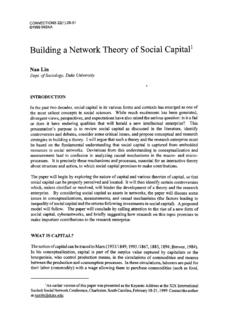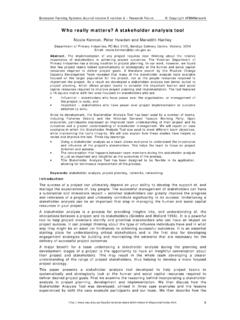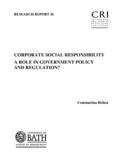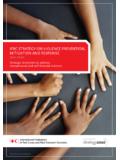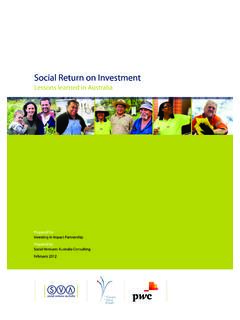Transcription of Respondent-Driven Sampling: An Assessment of …
1 Respondent-Driven sampling : An Assessment of current methodology Krista J. Gile and Mark S. Handcock December 1, 2008. Abstract Respondent-Driven sampling (RDS) employs a variant of a link-tracing network sampling strategy to collect data from hard-to-reach populations. By tracing the links in the underlying social network , the process exploits the social structure to expand the sample and reduce its dependence on the initial (convenience) sample. current estimation focuses on estimating population averages in the hard-to-reach population. These estimates are based on strong assumptions allowing the sample to be treated as a probability sample. In particular, we focus on three critical sensitivities of the estimators: to the without-replacement structure of sampling , to bias induced by the initial sample, and to uncontrollable features of respondent behavior.
2 First, estimates are based on a with-replacement random walk model, while the actual sampling is without replacement. We illustrate that when over half of the target population is sampled this approximation can lead to substantial bias in the resulting estimators. Previous research on the properties of RDS estimators has not considered this assumption. Second, we address the reduction of bias induced by the convenience sampling of the initial sample. RDS relies on many sample waves to create a type of mixing in the sampling process, much like the mixing in a Markov chain. We illustrate that the num- ber of sample waves typically used in RDS is likely insufficient for the type of nodal mixing required to obtain the reputed asymptotic unbiasedness of the estimators. In some cases, however, we find that despite this, the resulting estimators are approx- imately unbiased, although this is highly sensitive to the degree of clustering in the population and the number of waves in the sample.
3 Finally, we highlight the dependence of the estimators on characteristics of respon- dent behavior outside the control of the researcher. In particular, we illustrate the bias induced in the estimator by preferential coupon-passing behavior by respondents. We highlight the need to expand data collection to learn more about how respondents behave in RDS studies. This paper sounds a cautionary note for the users of RDS. While current RDS. methodology is powerful and clever, the good statistical properties claimed for the current estimates are shown to be heavily dependent on often unrealistic assumptions. 1. 1 Introduction to Respondent-Driven sampling Respondent-Driven sampling (RDS, introduced by Heckathorn 1997, 2002, see also Sal- ganik and Heckathorn, 2004, Volz and Heckathorn 2008) is an approach to sampling design and inference in hard-to-reach populations.
4 Hard-to-reach populations are characterized by the difficulty in sampling from them using standard probability methods. RDS is typically employed when a sampling frame for the target population is not available, and its mem- bers are rare or stigmatized in the larger population so that it is prohibitively expensive to contact them through available frames. It is often used in populations such as injection drug users, men who have sex with men, and sex workers (Malekinejad et al., 2008), al- though it has also been used in other populations such as jazz musicians (Heckathorn and Jeffri, 2001), unregulated workers (Bernhardt et al., 2006), and native American subgroups (Walters and Simoni, 2002). RDS presents two main innovations for this setting: a design for sampling from the tar- get population and a corresponding strategy for estimating properties of the target pop- ulation based on the resulting sample.
5 It is from the former that the method draws its name: the Respondent-Driven sampling design relies on the respondents at each wave to select or \drive" the next wave of sampling through their selection of other members of the target population. This is typically achieved through the distribution of coupons by respondents to other members of the target population. Thus, RDS exploits the network of social relations connecting the target population to facilitate sampling . This strategy also reduces the confidentiality concerns generally associated with sampling from stigmatized populations. The second main innovation is in estimating population characteristics based on the sample. As with most studies of hidden populations, a RDS sample begins with a con- venience sample of individuals. The key innovation is that through many waves of sam- pling, the dependence of the final sample on the initial convenience sample is presumably reduced.
6 The estimates of inclusion probabilities in current RDS inference rely on argu- ments based on a Markov Chain representation of the sampling process. This innovation was proposed by Salganik and Heckathorn (2004) and extended by Volz and Heckathorn (2008). RDS employs a link-tracing sampling design. In such designs, network links from sam- pled members of the target population are followed (traced) to select subsequent popula- tion members to add to the sample. In the case of RDS, the network links of interest are the social contacts facilitating the transfer of RDS coupons. Two population members related by such a link are said to be alters of one another. In the context of hard-to-reach popula- tions such strategies are often referred to as snowball samples (Goodman, 1961). Snowball sampling is useful in settings where a network of social relations links the members of the target population, such that previously sampled individuals can facilitate the sampling of others in the population.
7 Such samples are often very effective at recruiting large samples from hard-to-reach populations. Despite Goodman's probabilistic formulation, however, the initial wave is typically a convenience sample, such that the ultimate snowball sample is not a probability sample ( the probabilities of samples are not computable). There- fore, in most snowball samples from hard-to-reach populations, valid statistical inference requires additional tenuous assumptions. 2. In RDS, the initial sample (also know as the seeds or 0th wave) is assumed to be a con- venience sample, selected from among the members of the target population known to the researchers. Each respondent is then given a fixed small number of coupons to distribute among their alters in the target population. Each successive wave of the sample consists of population members who are given coupons by members of the previous wave and return those coupons to the survey center.
8 A respondent receives additional compensation for each successful recruitment. Respondents are also asked to report their numbers of con- tacts within the target population, to be used as an estimate of their nodal degree or number of alters. The passing of coupons reduces confidentiality concerns in marginalized popula- tions, and the dual incentive structure encourages the buy-in of participant-recruiters. The limited number of coupons and measurement of degree facilitate the estimation approach described in Section 2. RDS Addresses an Under-Served Need Absent Respondent-Driven sampling , frameworks for gathering probability samples of hard- to-reach populations are few and unappealing. A time-location sample (Muhib et al., 2001;. Peterson et al., 2008) will generate a probability sample, but that sample will be on the frame of times and locations, rather than population members.
9 A probability sample from a larger frame such as a door-to-door survey may generate a probability sample, but the rarity of the target population may make such a procedure prohibitively expensive. This type of study would also need to negotiate the difficult task of soliciting potentially sensi- tive information about membership in a marginalized population. It is also possible mem- bers of the marginalized population would be under-represented in a standard sampling frame. Among non-probability sampling methods, targeted sampling (Watters and Bier- nacki, 1989) is among the most promising. This approach combines extensive foundational research with a flexible form of quota sampling to improve the breadth of the sample. The resulting sample, however, is not a probability sample, and one study (Abdul-Quader et al., 2006) finds the resulting sample is less diverse than that of a parallel sample collected through RDS.
10 The need for RDS is demonstrated in the recent explosion of RDS studies, both in the US and abroad. Johnston et al. (2008) cite 128 current or completed RDS studies from 30. countries outside the US. These studies have taken place in several continents (Europe, Asia, South America, Africa, and Australia), and focused primarily on populations of in- jection drug users, men who have sex with men, and sex workers. Notable among the multitude of RDS studies in the is the recent use of RDS for behavioral monitoring by the Centers for Disease Control and Prevention (CDC). Abdul- Quader et al. (2006) describe this study, in which the CDC is using RDS for behavioral surveillance of high-risk HIV-related behaviors in the population of injection drug users. The overall study is called the National HIV Behavioral Surveillance System (NHBS), and consists of rotating studies in three high-risk populations: Men who have sex with men (MSM: NHBS-MSM), injection drug users (IDU: NHBS-IDU), and high-risk heterosexuals (NHBS-HET).
